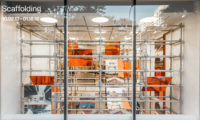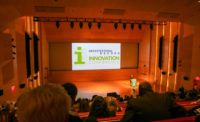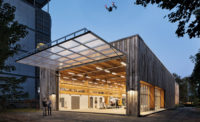While the theme of this year’s Milan Triennale, Broken Nature: Design Takes on Human Survival, waxes apocalyptic, the U.S. Pavilion there adopts a positive outlook, says its chief curator, Russell Fortmeyer, a sustainable design leader at Arup (and former Architectural Record editor). In response to the Triennale’s agenda to provide, according to its website, an “in-depth exploration of the strands that connect humans to the natural environment that has been intensely compromised, if not entirely severed, over the years,” the pavilion, called RECKONstruct, grapples with the ecological effects of processes of material extraction. RECKONstruct, a partnership led by ARUP including New York–based furniture company Humanscale, MIT’s SHINE Program, NextWave Plastics, and Stickbulb, “turns the spotlight on organizations that continue to push the industry to reduce material life cycle impact,” says Fortmeyer.
The pavilion nudges its visitors to be more conscientious about where designed objects come from, and where they end up. As part of the installation, Humanscale reimagined the common stool, developing three prototypes, each representing a different sustainable method: one stool, made from mycelium mushroom and agricultural waste, exemplifies how objects can be designed using naturally grown materials; the second, crafted from non-recyclable municipal waste, represents a circular economy approach; the last, inspired by the Venus Flower Basket sea sponge and made with a 3D printer, minimizes material use through additive manufacturing. While all three demonstrate low life-cycle output, the 3D printed stool, an example of biomimicry, used 80 percent less material than a baseline steel stool—significantly less than the two others, which used 20 to 30 percent less material.
As part of the installation, which includes lighting displays by Stickbulb made from centuries-old redwood salvaged from a dismantled water tower, Arup also produced an immersive, 360-degree film that takes viewers to a California coastal forest, a rock quarry in Kansas, a manufacturing facility, and a construction recycling yard. “The challenge with exhibitions such as the Triennale is that you are competing with a lot of content—quite often, people are wandering in a state of distraction,” says Fortmeyer. “We wanted to get visitors out of the confines of gallery space and immerse them in this world to help them understand what we mean by material life cycle impact. You can bring them to an active quarry to see all that happens there—the running water, the trucks—and the ecosystem associated with that quarry.”
As communicated by its title, RECKONstruct carries a message both urgent and hopeful by taking a productive approach to materials consumption. Open through September 1, the exhibit challenges its visitors to ponder the disconnect between us as consumers and the products that we buy. “The adage of do no harm is no longer enough,” says Fortmeyer, “Now it’s a matter of how we actually repair the harm that previous generations have done.”
The exhibition RECKONstruct runs through September 1 and will be open during Salone del Mobile / Milan Design Week (April 9-14), the Venice Biennale (May - November), Milano Arch Week (May), Milano Fashion Week (June), and Art Basel (June).
RECKONstruct includes an immersive sound and visual experience by Arup and Pacific Virtual Reality.









Post a comment to this article
Report Abusive Comment